Definition & Background:
Ancient Roman art was heavily influenced by Greek traditions but adapted to serve propaganda, commemorative, and practical purposes. Romans excelled in realism (verism) in portraiture, large-scale architecture, frescoes, mosaics, and sculptures that celebrated military conquests, emperors, and daily life. Innovations such as concrete and the arch allowed for monumental structures, including the Colosseum and aqueducts.
Five Key Ancient Roman Artists / Artworks:
-
Apollodorus of Damascus (c. 60–130 CE)
- Bio: A Syrian-Greek architect and sculptor, Apollodorus was one of the most influential designers of Roman architecture, particularly under Emperor Trajan.
-
Notable Works:
- Trajan’s Column – A massive relief-covered column narrating Trajan’s military victories.
- Trajan’s Forum & Markets – A large-scale complex in Rome showcasing Roman urban planning.
-
The Sculptors of the Augustus of Prima Porta (c. 20 BCE)
- Bio: While the specific sculptor remains unknown, this work exemplifies idealized Roman portraiture.
-
Notable Works:
- Augustus of Prima Porta – A marble statue of the first Roman emperor, idealized with divine imagery.
- Ara Pacis Augustae (Altar of Peace) – A detailed sculptural frieze celebrating Pax Romana.
-
The Artists of Pompeii & Herculaneum Frescoes (c. 1st Century CE)
- Bio: Roman wall painters created intricate frescoes in wealthy homes, preserving vibrant scenes of mythology, architecture, and daily life.
-
Notable Works:
- Villa of the Mysteries Frescoes – A Dionysian initiation scene found in Pompeii.
- House of the Vettii Frescoes – Elaborate paintings depicting gods, cupids, and mythological stories.
-
The Sculptors of the Equestrian Statue of Marcus Aurelius (c. 175 CE)
- Bio: The anonymous sculptor of this work crafted one of the few surviving bronze equestrian statues from antiquity.
-
Notable Works:
- Equestrian Statue of Marcus Aurelius – A rare, life-sized bronze statue of the philosopher-emperor.
- Reliefs on the Column of Marcus Aurelius – Narrative war scenes similar to Trajan’s Column.
-
The Mosaic Artists of Ravenna (c. 5th Century CE)
- Bio: Early Christian and Byzantine influences merged in Ravenna’s mosaics, illustrating religious and imperial themes.
-
Notable Works:
- Mosaic of Emperor Justinian (San Vitale) – Depicts the emperor surrounded by clergy and soldiers.
- Mosaic of Empress Theodora (San Vitale) – A richly detailed image of the empress in ceremonial attire.

